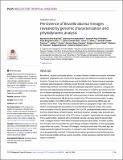| dc.contributor.author | Suárez-Esquivel, Marcela | |
| dc.contributor.author | Henández-Mora, Gabriela | |
| dc.contributor.author | Ruiz-Villalobos, Nazareth | |
| dc.contributor.author | BARQUERO-CALVO, ELIAS | |
| dc.contributor.author | Chacón-Díaz, Carlos | |
| dc.contributor.author | LadnerI, JasonT. | |
| dc.contributor.author | Oviedo-Sánchez, Gerardo | |
| dc.contributor.author | Foster, JeffreyT. | |
| dc.contributor.author | Rojas-Campos, Norman | |
| dc.contributor.author | Chaves-Olarte, Esteban | |
| dc.contributor.author | Thomson, Nicholas | |
| dc.contributor.author | Moreno, Edgardo | |
| dc.contributor.author | Guzman-Verri, Caterina | |
| dc.date.accessioned | 2020-06-12T23:50:49Z | |
| dc.date.available | 2020-06-12T23:50:49Z | |
| dc.date.issued | 2020-04-14 | |
| dc.identifier.uri | http://hdl.handle.net/11056/17567 | |
| dc.description.abstract | Brucellosis, caused by Brucella abortus, is a major disease of cattle and humans worldwide distributed. Eradication and control of the disease has been difficult in Central and South America, Central Asia, the Mediterranean and the Middle East. Epidemiological strategies combined with phylogenetic methods provide the high-resolution power needed to study relationships between surveillance data and pathogen population dynamics, using genetic diversity and spatiotemporal distributions. This information is crucial for prevention and control of disease spreading at a local and worldwide level. In Costa Rica (CR), the disease was first reported at the beginning of the 20th century and has not been controlled despite many efforts. We characterized 188 B. abortus isolates from CR recovered from cattle, humans and water buffalo, from 2003 to 2018, and whole genome sequencing (WGS) was performed in 95 of them. They were also assessed based on geographic origin, date of introduction, and phylogenetic associations in a worldwide and national context. Our results show circulation of five B. abortus lineages (I to V) in CR, phylogenetically related to isolates from the United States, United Kingdom, and South America. Lineage I was dominant and probably introduced at the end of the 19th century. Lineage II, represented by a single isolate from a water buffalo, clustered with a Colombian sample, and was likely introduced after 1845. Lineages III and IV were likely introduced during the early 2000s. Fourteen isolates from humans were found within the same lineage (lineage I) regardless of their geographic origin within the country. The main CR lineages, introduced more than 100 years ago, are widely spread throughout the country, in contrast to new introductions that seemed to be more geographically restricted. Following the brucellosis prevalence and the farming practices of several middle- and low-income countries, similar scenarios could be found in other regions worldwide. | es_ES |
| dc.description.abstract | La brucelosis causada por el abortus de Brucella es una enfermedad importante y de gran prevalencia en los países de ingresos medios y bajos de todo el mundo. Nuestros resultados, derivados de188B.abortus aislados de Costa Rica y de 221 genomas de la misma especie en todo el mundo, mostraron que en un lugar de un país pequeño (~51.100km2), hay al menos cinco linajes de B.abortus que circulan en su territorio. Además, por lo que respecta a las medidas de control, los linajes introducidos hace más de 100 años están muy extendidos por todo el país, lo que contrasta con las introducciones más recientes que parecían estar restringidas geográficamente. Con el fin de realizar un análisis furánico, elaboramos una hoja de ruta basada en un enfoque integrador que puede mejorar la comprensión de la dinámica de las enfermedades. Siguiendo la prevalencia de la brucelosis y las prácticas agrícolas de varios países de ingresos medianos y bajos, se podrían encontrar escenarios similares en otras regiones del mundo, en las que nuestros métodos podrían ser útiles y aplicarse de forma similar. | es_ES |
| dc.language.iso | eng | es_ES |
| dc.publisher | PLOS Neglected Tropical Diseases | es_ES |
| dc.rights | Acceso abierto | es_ES |
| dc.rights.uri | http://creativecommons.org/licenses/by-nc-nd/4.0/ | |
| dc.source | PLoS Negl Trop Dis 14(4):e0008235. | es_ES |
| dc.subject | BRUCELLA ABORTUS | es_ES |
| dc.subject | BRUCELOSIS | es_ES |
| dc.subject | COSTA RICA | es_ES |
| dc.subject | BACTERIAS | es_ES |
| dc.subject | ENFERMEDADES BACTERIANAS | es_ES |
| dc.subject | AMÉRICA CENTRAL | es_ES |
| dc.subject | CENTRAL AMERICA | es_ES |
| dc.title | Persistence of Brucella abortus lineages revealed by genomic characterization and phylodynamic analysis | es_ES |
| dc.type | http://purl.org/coar/resource_type/c_6501 | es_ES |
| dc.description.procedence | Escuela Medicina Veterinaria | es_ES |
| dc.identifier.doi | 10.1371/journal.pntd.0008235 | |


